The effect of Pre-Competitive Anxiety on Coping Strategies used by U15 Elite Footballers Affiliated in the Training Sector Centers of the Tunisian Football Federation
Jamel Hajji1,2* and Ali Elloumi3,4
1Department of Sciences Education, University of Tunis, Tunisia
2 Higher Institute of Sport and Physical Education Gafsa, Gafsa University, Tunisia
3 Department of Arts and Sciences Social, Sfax University, Tunisia
4Laboratoire Techniques et Enjeux du Corps, University Paris Descartes, France
Submission: July 24, 2018; Published: October 24, 2018
*Corresponding author: Jamel Hajji, Department of Sciences Education, Faculty of Humanities at Tunis, University of Tunis, Higher Institute of Sport and Physical Education Gafsa, Gafsa University, Tunisia.
How to cite this article: Jamel H, Ali Elloumi. The effect of Pre-Competitive Anxiety on Coping Strategies used by U15 Elite Footballers Affiliated in the Training Sector Centers of the Tunisian Football Federation. Psychol Behav Sci Int J. 2018; 10(1): 555777. DOI: 10.19080/PBSIJ.2018.10.555777.
Abstract
The neglect of psychological coaching among elite football players in the Tunisian Football Federation’s sectoral training centers has created a state of ambiguity regarding the two-dimensional treatment of anxiety and coping. The objective of this statistical study is to interpret all predictive relations that exist between our participants between precompetitive anxiety and coping on the one hand and between precompetitive anxiety and coping through the mediation of coaching, the experience and technical position of each player on the other hand, and to understand if anxiety management is appropriate for their level of elite. These interaction relationships were statistically processed through multiple linear regression analyzes to examine direct predictive interaction and through PROCESS v2.16.3 macro model 4, Hayes Andrew et al. [1], to examine indirect predictive interactions. The results indicate that all the coping strategies used by our elites have been predicted directly by the different dimensions of pre-competitive anxiety. On the other hand, all existing indirect predictive relationships have been explained by the effect of coaching mediation and technical position.
Keywords: Anxiety; Coping; Mediation; Coaching; Experience; Technical position
Introduction
The youth sports environment is shaped by a multitude of major sports, social and economic issues. It is in this particular arrangement that the athlete must achieve a performance that could trace the rest of his career. The technique, the physics, the tactics, and the management of the stress, are essential factors so that the performance of the athlete is at the closest of his potentials. Young elite athletes developed in an institutional system such as training centers, are not exempt from the daily confrontation marked by enormous constraints relevant to competition and performance. In the psychological context stress is the most important tension. According to Christine Le Scanff [2], the need to combat the causes of organizational stress is a priority for sports psychology specialists.
Mental training is an essential means to help the elite athlete develop their different psychological qualities to combat the high-level stressful environment Anshel Mark et al. [3]. High performance athletes are those who can successfully manage stressful events [4,5]. On the other hand, high-level athletes keep the best strategies to control the threatening competitive situation [6,7].
The athlete-competition relationship was explained by the transactional approach of Lazarus Richard and Folkman Susan [8], as a two-process function. The evaluation (first and second evaluation) and the coping strategy. The emotional impact of competition on the young athlete has always been a fundamental concern. The influence of stress or anxiety is one of the most important tests to be solved by sports researchers in young athletes Gould Daniel et al. [9]. Many sources of stress have been established in the young athlete’s relationship with competition Smith Ronald et al. [10]. Competition is an opportunity to confirm athletic competence, and to measure one self against others. It is also a precious moment to evaluate the athlete by his entourage and especially by influential people such as parents, peers, leaders and coaches.
Methodology
Population
These are 76 Tunisian U15 footballers (average age = 14.00, standard deviation = 0.327), affiliated to the four sectoral pretraining centers. These athletes are subject to a pre-training program supervised by the Tunisian National Technical Department. Our athletes are housed in homes and are subject to an adequate school system for daily training. Every weekend they join their home clubs for Sunday’s competition. Sectoral and national groupings were made to select the best to join the U15 Tunisian national team.
Measuring Instrument
To study the manifestation of pre-competitive situational anxiety in our participants and to measure the intensity, direction and frequency of cognitive, somatic, and pre-competitive selfconfidence anxiety a few minutes before the sport competition, we used the version Tunisian revised inventory of state anxiety for the sporting competition CSAI-2R, Hajji Jamel et al. [11]. To identify the coping strategies used to deal with pre-competitive situational anxiety among our elites, we used the Arabic version of the coping strategies inventory of the ISCCS sports competition, Hajji Jamel et al. [12] with its Ten top-notch coping strategies divided into three super-second-order factors: taskbased coping, distraction-based coping, and disengagementbased coping.
Procedure
The data collected in this study were processed through multiple linear regression. These analyzes were administered in two stages, to identify all the explanatory links existing between all the components of pre-competitive anxiety and coping strategies. The first step relates to locating the predictive effects through the coaching factors, level of experience and technical position. In this step we used linear regression with the “stepby- step” method and the “filter variable” technique.
The second step, relates to the examination of the total indirect effect imposed by pre-competitive anxiety on the coping strategies used, and to the study of the mediating effect of coaching, level of experience and position technical. In this step we used model 4 of the PROCESS macro v2.16.3, Hayes Andrew et al. [1].
Results
Direct Predictive Effects
The results obtained are all indicated in the (Tables 1-6).
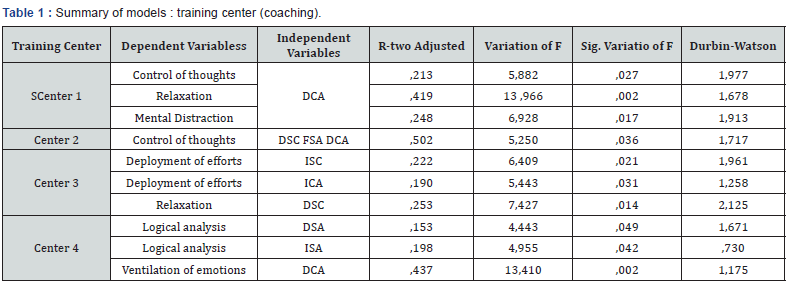
Direct predictive effects relative to the coaching factor
Direct predictive effects relative to level of experience
The Mediation Effect of Coaching, Experience and Technical Position
The results of the indirect effect of coaching mediation, level of experience and technical position are shown in (Table 7).
Discussion
Direct predictive effects
Dependent variables to predict are task-oriented coping strategies, disengagement and distraction, while independent variables are the different dimensions and measures of precompetitive anxiety. We have opted for multiple linear regression analyzes to assess whether, and to what extent, precompetitive anxiety can predict the coping strategies implied by our young elites to manage a competitive environment.
i. The coefficients of the multiple linear regression indicate that we did not have problems of multi-collinearity since there are no perfect linear relations between the independent variables. Consequently, the correlations are not too strong and all the values of the tolerance and VIF (Variance Inflation Factor) for the different models are close to 1 see the (Tables 2, 4 & 6).
ii. For error independence, residual values are not correlated between individuals. The Durbin-Watson values of all models work around the value 2, indicating the lack of correlation. In general, these values are in the range [1, 3] (Tables 1, 3 & 5).
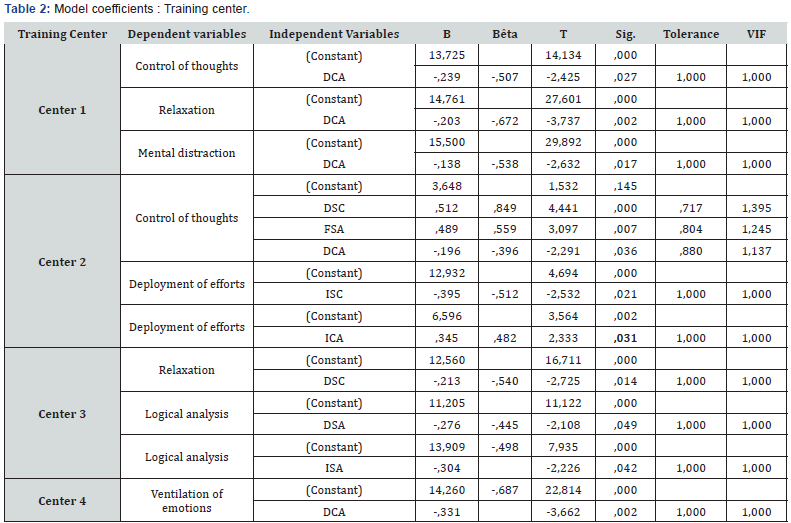
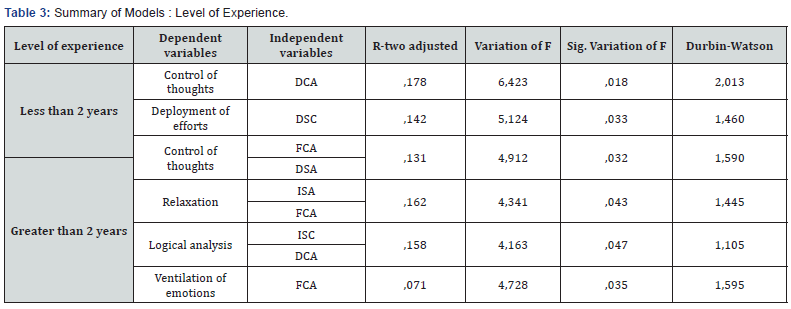
iii. Adjusted R2 is an index adjusted to explain the relationship between dependent variables and independent variables. This index represents the strength of the predictive relationship and the percentage of variance explained by the model (the combination of the independent variables). In our study, the adjusted R2 values significant at p ˂ 0.05, fluctuate between 0.045 and 0.466 which proves that the data are satisfactorily adjusted to the model and sometimes inadequately.
iv. Another index is centralized by our analysis: it is the standardized regression coefficient “Beta”, which explains the variation of the variable to predict Y when we vary by one unit the dependent variable X. This index indicates the change in standard deviation of the dependent variable for each one standard deviation increase of the independent variable when the other values are constant. The standardized regression coefficient “Beta” verifies the weight or predictive power of the model. The absolute values of the standardized regression coefficient “Beta” of our models are between 0.241 and 0.725, which means that the power of our models evolves from satisfactory to good.

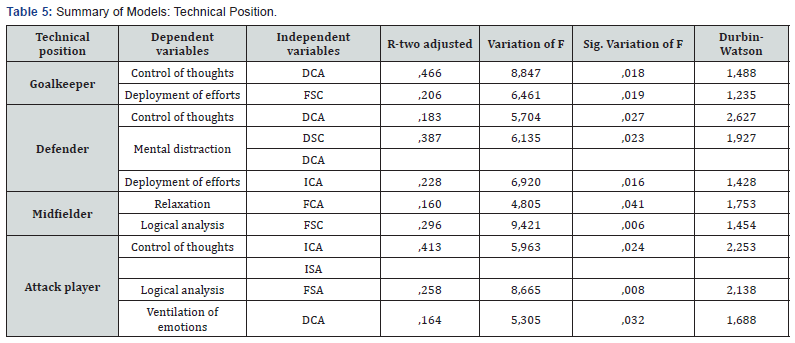
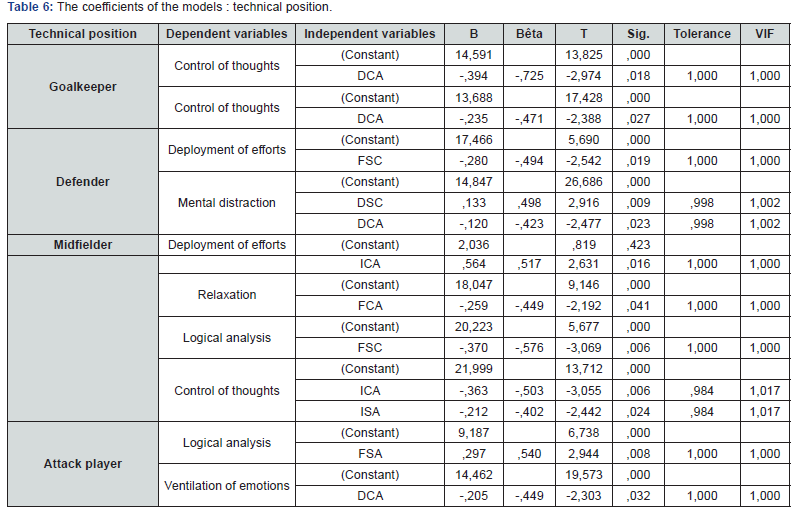
The coping strategies revealed by multiple linear regression analyzes, represent the three categories of coping :
a. Task-oriented coping : logical analysis, control of thoughts, relaxation, Deployment of efforts.
b. Disengagement-oriented coping : ventilation of unpleasant emotions.
c. Distraction-oriented coping : mental distraction.
These coping strategies used by our elites have been predicted by all dimensions and measures of pre-competitive anxiety, this proves that the use of coping by our elites is irregular. Recently, researchers like [13-18] have shown that elite athletes often use task-oriented coping strategies, such as effort expenditure, thought control, relaxation, logical analysis, mental imagery, and support seeking to cope with stressful situations.
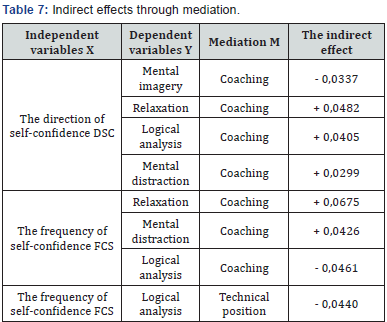
Indirect Predictive Effects
The regression analyzes through model 4 of PROCESS macro v2.16.3, Hayes Andrew et al. [1], indicate the effects of mediation of coaching and technical position that indicates the importance of the effect of the coach and the effect of the player’s technical position on the field. These results converge with those published in the work of Martin Eric et al. [19-21] for coaching, and in the work of Najah Amira et al. [22] and Thelwell Richard et al. [23] for the technical position.
Conclusion
Our elites in the sectoral training centers supervised by the National Technical Direction of the Tunisian Football Federation, do not admit the profile of an elite athlete characterized by a task-oriented coping repertoire. This can be explained by the fact that they have not been subjected to a program of psychological preparation. The impact of the psychological state on the athlete’s performance is as important as the technical and tactical skills. For this reason, there should be more interest in training programs Taylor Jim et al. [24].
The psychological requirements imposed by the trainer coach (coaching), and by the technical position, are important factors that may be related to the mental skills of the athlete. These factors are among the guidelines of our doctoral research. Mental abilities were often studied with respect to coaching [25,26] and experience level [27,28], but few studies have examined technical positions Cox Richard et al. [29].
Limits
Some limitations were revealed during this study. Our participants were examined through factors, coaching, experience and technical position, while factors like competence (elite and non-elite) were omitted. De Bosscher Veerle et al. [30], state that micro-factors corresponding to the individual characteristics (genetics) of the athlete and to the family context, peers, coaches… must be controlled in elite athletes in training centers who present complicated and likely stations to reach the high level.
References
- Yavuz KF, Türkçapar MH, Demirel B, Karadere E (2011) Adaptation, validity and reliability of the Leahy Emotional Schema Scale Turkish version based on Turkish university students and workers. Dusunen Adam 24(4): 273-282.
- Leahy RL (2003) Roadblocks in Cognitive-Behavioral Therapy: Transforming Challenges into Opportunities for Change. The Guilford Press, New York.
- Beck AT, Freeman A (1990) Cognitive Therapy for personality disorders. Guilford Press, New York.
- Young JE (1999) Cognitive Therapy for personality disorders: A Schema Focused approach. FL: Professional Resourcee Press, Sarasota, Florida.
- Leahy RL (2002) A model of emotional schemas. Cognitive and Behavioral Practice 9(3): 177-190.
- Stevens J (2011) Confirmatory and Exploratory Factor Analysis. In: Applied Multivariate Statistics for the Social Sciences, Yavuz KF, Türkçapar MH, Demirel B, Karadere E (Eds.), (4th edn.), Lawrence Erlbaum Ass, New Jersey, USA, pp: 385-454.
- Young JE (2005) Schema-focused cognitive therapy and the case of Ms. S. Journal of Psychotherapy Integration 15(1): 115-126.
- Kim J, Mueller CW (1978) Construction of Factor Scales. In: Factor Analysis: Statistical Methods and Practical Issues. (1st edn.), Sage Publications, California, USA, p: 60-73.
- Dadsetan P (2007) Psychopathology transition from childhood to adulthood. Samt publications, Tehran, Iran.
- Leahy RL (2001) Overcoming Resistance in Cognitive Therapy. The Guilford Press, New York
- Leahy RL (2015) Emotional Schema Therapy. Guilford Press, New York.
- Leahy RL (2012) Introduction: Emotional schemas, emotion regulation, and psychopathology. International Journal of Cognitive Therapy 5(4): 359-361.
- Leahy RL (2006) Emotional schemas and self-help: Homework compliance and obsessive-compulsive disorder. Cognitive and Behavioral Practice 14(3): 297-302
- Leahy RL (2007) Emotional schemas and resistance to change in anxiety disorders. Cognitive and Behavioral Practice 14(1): 36-45.
- Leahy RL (2008) The therapeutic relationship in cognitive-behavioral therapy. Behavioral and Cognitive Psychotherapy 38: 769-777
- Leahy RL (2003) Cognitive Therapy Techniques. Fati L (Ed.), Tehran: Dangeh publications, Iran
- Sava FA (2009) Maladaptive schemas, irrational beliefs, and their relationship with the five-factor personality model. Journal of Cognitive and Behavioral Psychotherapies 9(2): 135-147
- Scott Mears G (2012) Examining the relationship between emotional schemas, emotional intelligence, and relationship satisfaction. A Dissertation Presented in Partial Fulfilment of the Requirements for the Degree Doctor of Philosophy. Liberty University, USA.






























